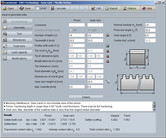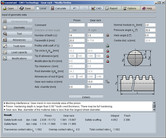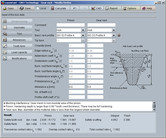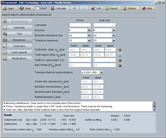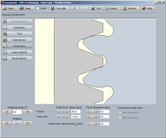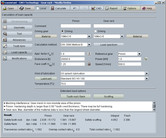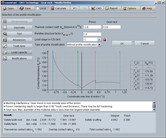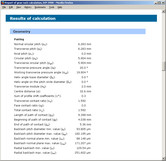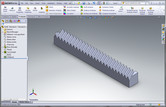Celler Straße 67 - 69
38114 Braunschweig
Germany
Fon: +49 (0) 531-129 399 0
Fax: +49 (0) 531-129 399 29
Mail: info@tbksoft.com
Web: http://www.gwj.de
Rack / pinion gear pairs according to DIN 3990, ISO 6336 and further standards
Features
- Geometry of spur and helical involute pinions with gear rack according to DIN 3960, DIN 3961, DIN 3964, DIN 3967, DIN 3977 and DIN 868
- Rectangular or round gear racks are possible
- Consideration of profile shift including a dimensioning function for balanced specific sliding
- Extended range for possible profile shift
- Definition of working centre distance or calculation from given profile shift
- Gear quality and tooth thickness tolerances can be selected from listboxes or can be defined individually
- Addendum chamfer can be considered in the calculation
- Standardised basic rack tooth profiles for tools according to ISO 53, DIN 867 and DIN 3972 can be selected or individually definded, protuberance tools with or without allowance, dimensioning function for special basic rack tooth profiles
- Full-depth teeth and stub tooth gears
- Type of tools: hob, gear shaper cutter and constructed involute
- Determination of test dimensions, suggestion for number of teeth for span measurement as well as suggestion for ball/pin diameter for measurement over balls or pins
- Calculation of the tooth thickness allowances based on measured values or given test dimensions
- Calculation of form diameter of addendum and dedendum
- Check for meshing interferences based on the accurate gear tooth form
- Display of the accurate gear tooth form with animation/simulation of the tooth mesh
- Definition and consideration of profile modifications: linear and circular tip relief, linear and circular root relief, symmetric profile crowning
- Definition of flank modifications: end relief, symmetric and asymmetric lead crowning
- Calculation with non-integer number of teeth, i.e., number of teeth with decimal places (available on request)
- Calculation with helix angle greater than 45 degree (available on request)
- Calculation of load capacity according to DIN 3990 Method B, ISO 6336 Method B and ISO/TR 13989 (scuffing) with integrated material and lubricant database
- Calculation of load capacity with load spectrum according to ISO 6336 Part 6, determination is based on the Palmgren-Miner rule: load-dependent K-factors are calculated for each torque class; safeties are determined by way of iteration until the sum of damage parts is obtained
- Diagram of flash temperature (contact temperature)
- Consideration of grinding notches in the load capacity calculation
- Optimal hardening depth, manual input of hardening depth and consideration in the load capacity calculation
- Selection of mode of operation is possible for swelling, alternating and oscillating
- Power loss by tooth friction, gearing efficiency according to Niemann
- Calculation of the safeties for fatigue or limited life strength and static strength (tooth root, flank/pitting, scuffing)
- Detailed calculation report as well as short calculation report for manufacturing in HTML or PDF format
- Output of CAD data via TBK CAD-PlugIns or DXF interface
Description
This gear calculation module allows a simple calculation of the geometry and load capacity of rack-pinion gear pairs. The geometry calculation is based on DIN 3960, DIN 3961, DIN 3964, DIN 3967, DIN 3977 and DIN 868. Spur and helical involute pinions are possible to calculate. Profile shift, addendum chamfer and allowances will be taken into consideration. Gear quality and tooth thickness tolerances can be comfortably selected from listboxes. The working centre distance can be either defined for the calculation or determined from the profile shift. Different standardised tool basic rack profiles according to ISO 53, DIN 867 and DIN 3972 can be selected or defined individually for the calculation. Full-depth teeth and stub tooth gears can be calculated as well. Furthermore, the test dimensions for the gearing are determined. For that, the required number of teeth for the span measurement as well as the ball or pin diameter will be determined automatically. Optionally, the values can be defined by the user. In addition, a backward calculation of the tooth thickness allowances from the test dimensions is also possible.
One particular highlight of the calculation module is the representation of the calculated gear tooth form with animation/simulation of the tooth mesh. For this representation, the minimum, mean and maximum allowances for the tooth thicknesses and tip diameters can be selected. The program also gives hints and warnings, for example in terms of gear tolerances which appear in the calculation report depending on the gear quality. A check for meshing interferences occurs in the background based on the accurate gear tooth form.
In addition to the geometry calculation, the load capacity calculation according to DIN 3990 Method B is also available. Herewith the safeties for fatigue or limited life strength and static strength can be calculated. The calculation of surface durability (pitting), tooth bending strength and scuffing according the flash and integral temperature method is carried out. A diagram for the contact temperature over the length of the line of action is also available.
Alternatively, the load capacity calculation of the surface durability (pitting) and tooth bending strength according to ISO 6336 (2008) Method B can be selected. For the scuffing load capacity the ISO/TR 13989 is integrated.
There is a calculation of load spectra for cylindrical gears according to ISO 6336 Part 6. The determination is based on the Palmgren-Miner rule and the load-dependent K-factors are calculated for each torque class. The safeties are determined by way of iteration until the sum of damage parts is obtained. This method, demanded by the wind energy industry, is very accurate.
The materials and the lubricant can be comfortably selected from the database. Furthermore, other effects (grinding notches, mode of operation, etc.) can be taken into consideration.
The module includes all typical eAssistant functions, for example the redo and undo function and the creation of a calculation report in HTML and PDF format. Various templates, such as a short or standard report, can be used for the generation of the calculation report.

